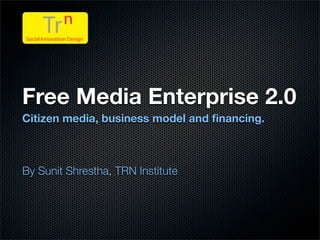Free Media Enterprise 2.0
- 1. Free Media Enterprise 2.0 Citizen media, business model and ïŽnancing. By Sunit Shrestha, TRN Institute
- 2. Information is the currency of democracy Thomas Jefferson
- 3. We all know how internet-enabled citizen journalism/media is emerging and could change everything. ïŽnancial SUSTAINABILITY is yet still a big issue.
- 4. No sustainability No real growth No partnership No long-term impact Just an insigniïŽcant niche ? Just another hype in the dead-pool ?
- 5. Spectrum of citizen media... No-time Part-time Full-time Over-time High expected quality / capital requirement Free media enterprise hard-core bloggers / podcasters Area of interest typical bloggers / podcasters Low expected quality / capital requirement
- 6. {} + citizen media What to do for ? + supporters investors donors
- 7. Especially those emerging in developing countries.
- 8. Business model development Product & service Cost structure Revenue / funding
- 9. Product & Service BASICS Uniquely competitive content (faster, different, agenda-setting, insight, gossip, etc.) Robust delivery format (website, e-newsletters, podcasts, printed media, mobile, etc.)
- 10. Product & Service âĒ Capacity service option Leverage unique media capacity to service others with strategic ïŽt. âĒ Reality-check growth âĒ More sustainable âĒ Lower startup risk âĒ CAUTION: Distraction & time to market
- 11. Product & Service Capacity service option: Emerging Cases Center for Independent Journalism, Malaysia Community journalism capacity DuoCore, Thailand Podcasting capacity Siam Intelligence Unit, Thailand Data management & communication capacity
- 12. Cost structure Assuming low delivery cost, the worrying cost is in the content generation model. Crowd / Editorial High control Low control Hybrid community High cost Low/medium cost team DifïŽcult to scale Highly scalable sourcing
- 13. Editorial team approach Prachatai.com Malaysiakini.com
- 14. User-generated media enterprise Crowd / community sourcing as long tail aggregator & facilitator. Manage monetary & non-monetary incentives along the tail. Recognition, Media creation incentive spectrum belonging, Money non-monetary ProïŽt threshold for ProïŽt threshold for stores physical stores (like with no retail overhead ProïŽt threshold Tower Records) (like Amazon.com) for stores with no physical goods (like Rhapsody) Beyond bricks and mortar there are two main number of products they can sell proïŽtably. retail models â one that gets halfway down Pushing this even further are pure digital the Long Tail and another that goes all the services, such as iTunes, which o!er the addi- way. The ïŽrst is the familiar hybrid model tional savings of delivering their digital goods of Amazon and NetïŽix, companies that sell online at virtually no marginal cost. Since an
- 15. Open source approach NowPublic.com: 12 million USD funding
- 16. (Open source approach).in.th Blognone.com Palawat.com DuoCore.tv
- 17. Hybrid approach PoliticalBase.com OhmyNews.com (Korea) 37,000+ citizen reporters 48 staff reporters
- 18. REVENUE COMBINATIONS Subscription (with large enough audience ïŽrst) Content provider to other media intermediary such as cable network, mobile, etc. Publication & physical media release Events / seminars / work-shops Capacity service such as research, podcasting, training, data analysis, etc.
- 19. Investment funding Grants hybrid Loans Equity Friedrich Naumann Foundation | Open Society Institute Media Development Loan Fund | SEAPA ResponAbility | SIDA | YSEI
- 20. Scale-up funding case in point Media Development Loan Fund
- 21. What investors/donors/ supporters should do? Share investment information & develop partnership Micro venture capital focusing on free media enterprise. Consolidate funding. Explore innovative funding instrument such as loan-like grant, equity-like grant and equity-like loan. Guarantee instrument for collateral option.





















